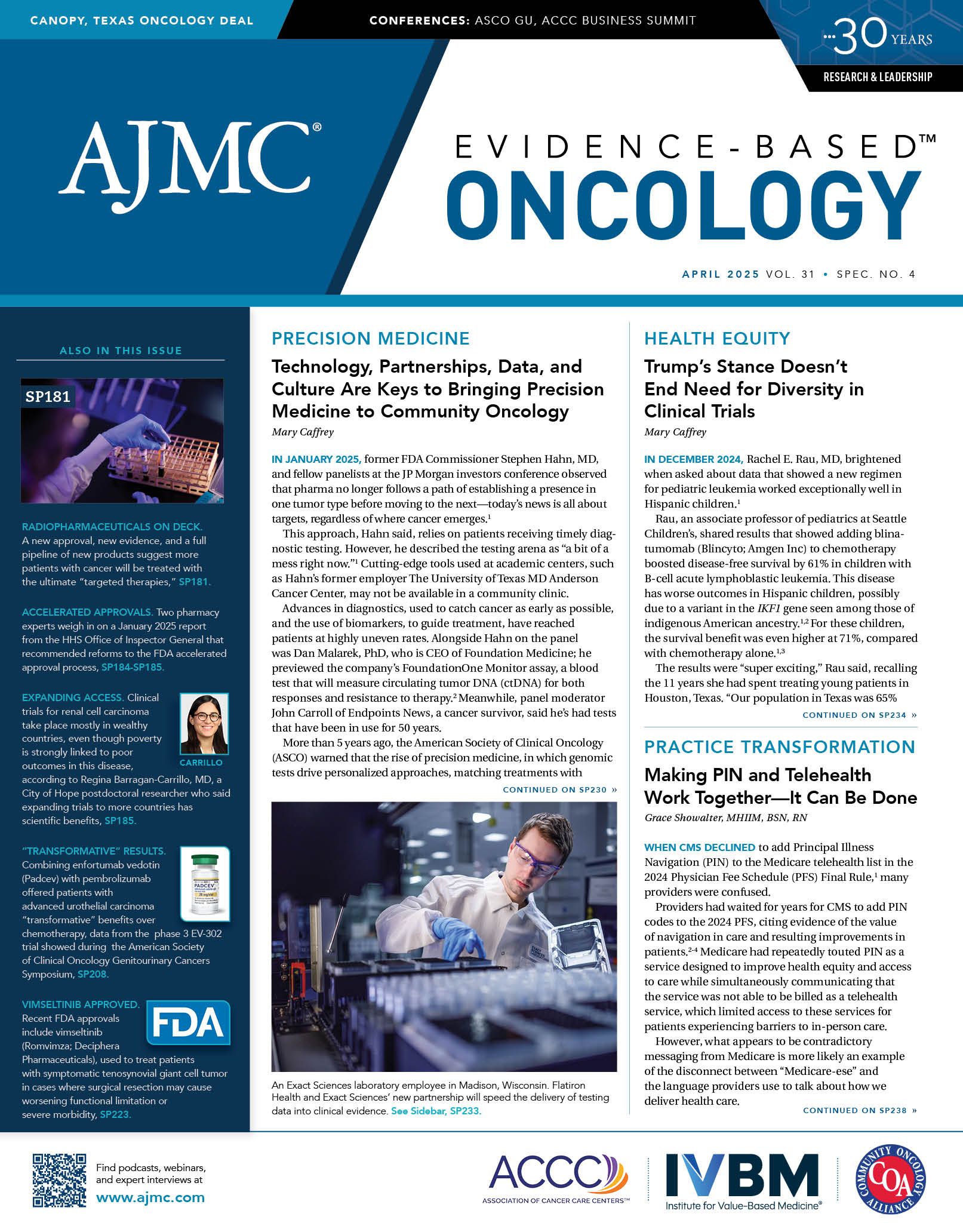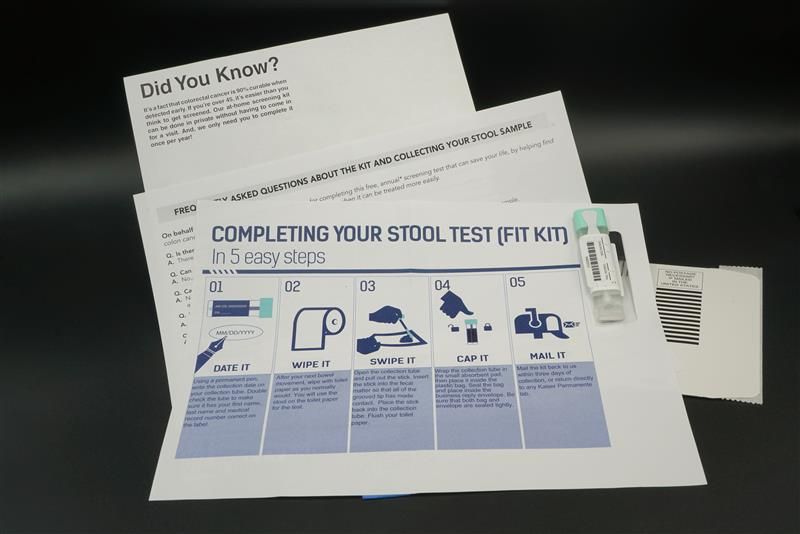Publication
Article
Evidence-Based Oncology
Trump’s Stance Doesn’t End Need for Diversity in Clinical Trials
Author(s):
Key Takeaways
- Blinatumomab combined with chemotherapy increased disease-free survival by 61% in children with B-cell acute lymphoblastic leukemia.
- Hispanic children, who often face worse outcomes, saw a 71% survival benefit with the new regimen.
In December 2024, Rachel E. Rau, MD, brightened when asked about data that showed a new regimen for pediatric leukemia worked exceptionally well in Hispanic children.1
Rau, an associate professor of pediatrics at Seattle Children’s, shared results that showed adding blinatumomab (Blincyto; Amgen Inc) to chemotherapy boosted disease-free survival by 61% in children with B-cell acute lymphoblastic leukemia. This disease has worse outcomes in Hispanic children, possibly due to a variant in the IKF1 gene seen among those of indigenous American ancestry.1,2 For these children, the survival benefit was even higher at 71%, compared with chemotherapy alone.1,3
Rachel Rau, MD | Image provided by ASCO

The results were “super exciting,” Rau said, recalling the 11 years she had spent treating young patients in Houston, Texas. “Our population in Texas was 65% Hispanic—so that one tugged at my heartstrings…when I saw that substantial improvement.”3
Rau’s presentation at the 66th American Society of Hematology Annual Meeting and Exposition underscored why the FDA and professional societies have spent a decade pushing for clinical trial enrollment to mirror the US population—or, preferably, those most likely to develop the disease being studied. It is the same reason investigators who study multiple myeloma hope to enroll more Black patients4 and why specific lung cancer trials enroll more Asian patients5: Genetic differences and underlying comorbidities mean some patient populations face greater risk from certain cancers than others. Knowing how drugs will work among the patients most likely to need them is crucial.4-6
In June 2024, the FDA addressed this in a draft guidance, calling for pharmaceutical companies to submit diversity action plans for certain trials and to develop strategies to boost enrollment among underrepresented groups.7 But now, the future of the FDA’s effort is in doubt. On January 23, 2025, the guidance web page vanished as the Trump administration took early, aggressive steps to eliminate diversity, equity, and inclusion (DEI) programs in the federal government, which included canceling National Institutes of Health (NIH) grants and removing online data sets.8,9
The courts have reversed some actions, and the FDA guidance page was restored with a disclaimer.10 But elsewhere, the administration has taken aim at DEI efforts in higher education and the private sector. Although not directed at clinical trials, these steps could affect progress toward building a more diverse workforce, which experts say is necessary to build trust with underrepresented communities.11 Major institutions, such as the Fred Hutchinson Cancer Center, folded their DEI programs to avoid losing federal research funds.12
Yet the need for trials that reflect populations taking new drugs has not disappeared. Experts say giving all patients access to trials and making studies reflect the population in need is not a feel-good exercise but a scientific necessity. This is due to gains in precision medicine, demographic shifts, and increased awareness of the role of health-related social needs in clinical outcomes.13-15
Martin Makary, MD, MPH | Image: Johns Hopkins

Martin Makary, MD, MPH, confirmed on March 25, 2025, as the new FDA commissioner, told a Senate committee that he supported diverse clinical trials, but whether that translates into a final guidance remains to be seen. “I believe in common sense, and I believe in clinical trial diversity,…so I believe if you’re going to [extrapolate] results to the general population, you should have results in those populations [for which] you’re making recommendations,” Makary said.16
Prior to January, the FDA had made slow but steady progress in its pursuit of broader representation in drug trials. Pharmaceutical companies built stronger ties with community practices, enabling patients to access new drugs without traveling.
“The FDA has been helpful with their guidance to inform biotech about wanting the clinical trial patients to try to mirror the US Census, to have [the population] look like the patients that are going to be prescribed,” said Howard A. “Skip” Burris, MD, president of Sarah Cannon Research Institute, which now extends across 24 states and 250 sites of care.
Howard A. "Skip" Burris III, MD | Image: Sarah Cannon Research Institute

Concerns about patient access touch on issues beyond race and ethnicity, said Burris, who was president of the American Society of Clinical Oncology (ASCO) from 2019 to 2020. He highlighted efforts by Monica Bertagnolli, MD, formerly ASCO president and recently director of NIH, to give rural patients better trial access.17 Incidence of cancer types can also vary from country to country, Burris said, and the FDA has worked to ensure that trials enroll enough US patients.
“While clinical trials are very strict in terms of eligibility criteria, the fact is, once that drug has a label, doctors are giving it to everybody,” he said. “So, if it’s not been studied in different ethnic groups and it hasn’t been studied in different populations by age or comorbidities or whatever disparities might exist, you really are flying a little bit blind with those patients.”
Tanya B. Dorff, MD, a professor in the Department of Medical Oncology and Therapeutics Research and section chief, Genitourinary Disease Program, at City of Hope, agreed that the scientific community would remain committed to improving patient access to trials, regardless of the political environment. Dorff spoke with Evidence-Based Oncology (EBO) during the ASCO Genitourinary (GU) Symposium, February 13 to 15, 2025. Some attendees were shaken by reports of NIH funding changes and layoffs.
Tanya B. Dorff, MD | Image: City of Hope

“We’re always thinking about how to reduce clinical trial burden [and] unnecessary exclusionary criteria that result in bias as to which patients end up enrolling. That’s not going to go away because of whatever is happening now,” Dorff said. “That thought process, and that initiative in how we write our trials, how we talk to patients, how we retain them, [is] not just about enrolling patients but keeping them on study. And I am hopeful that we will…continue to make improvements in [the] diversity of our accrual.”
Executive Orders That Could Affect Trials
On the day he returned to office, President Trump issued an executive order (EO) relevant to the FDA draft guidance. As attorneys from Crowell & Moring LLP noted, the order directed all executive departments and agencies to end DEI efforts by eliminating “discriminatory and illegal preferences, mandates, policies, programs, activities, guidance, regulations, enforcement actions, consent orders, and requirements.”18 According to the firm’s notice, the order reined in the Office of Federal Contract Compliance Programs’ authority and instead called on agencies to “scrutinize the DEI practices of private sector employers.”19 As the attorneys pointed out, the EO bars the office from promoting diversity or enforcing affirmative action. However, the attorneys also wrote, “Significantly, the EO is directed at DEI programs and practices that violate federal antidiscrimination laws—not all DEI efforts.”19 Days later, Crowell attorneys noted that the FDA guidance was required under the Food and Drug Omnibus Reform Act (FDORA), which has not been rescinded.20 FDORA requires final guidance to be issued by June 26, 2025.
Following a court order on February 11, 2025, to restore government websites, the FDA draft guidance features a disclaimer referring to a separate EO on the transgender community. The disclaimer states in part, “Any information on this page promoting gender ideology is extremely inaccurate and disconnected from the immutable biological reality that there are two sexes, male and female.”7
The Need for Trials to Reflect Populations
Many factors are behind the call for greater diversity in clinical trials, but the most basic one is America’s changing demographics: US Census data released in August 2021 showed that the White population makes up 58% of the United States, the smallest share in the nation’s history. Hispanic Americans now account for 18.7% of the population, with Black Americans at 12.1% and Asian Americans at 7%. Notably, the White population is shrinking; it fell from 223.6 million in 2010 to 204.3 million in 2020.21 The FDA reported that White patients are overrepresented in clinical trials, accounting for 75% of participants. In contrast, Black patients (8%) and Hispanic patients (11%) are underrepresented.22
William L. Dahut, MD | Image: American Cancer Society

Lack of representation in clinical trials is one reason Black patients are more likely to die from cancer, according to the American Cancer Society, whose journal featured the article “Cancer Statistics for African American and Black People, 2025” in February.23 Although outcomes gaps have shrunk due to declining smoking rates among younger patients, over the past 5 years, the authors wrote, “Black men had 16% higher mortality than White men despite just 4% higher incidence, and Black women had 10% higher mortality than White women despite 9% lower incidence.” Mortality rates for Black patients are twice as high in prostate, uterine corpus, and stomach cancers and myeloma and are 40% to 50% higher in colorectal, breast, cervical, and liver cancers.23
Diversity in enrollment is more important when a given cancer poses a greater risk to minority groups. For example, EBO reported in November 2024 that Black patients accounted for about 1% of enrollment in 2 recent trials on cutting-edge quadruplet therapy in frontline multiple myeloma (MM). Meanwhile, Black patients make up 20% of all those with MM and will account for 24% in 2035.4 As scientists learn more about the way genetics affect disease progression, the need for more representative trials grows. Findings presented at the most recent meeting of the International Myeloma Society show that race plays a major role in the pace of “immunologic aging,” which tells scientists how quickly precursors to MM will progress to full-blown disease.24
Finally, there is recognition that social factors such as tobacco or alcohol use or access to adequate food, housing, or transportation affect trial outcomes. A patient’s ability to afford cost-sharing may also affect results if patients are less likely to adhere to a medication.25
Examples like this show why payers are increasingly skeptical about covering expensive cancer drugs when trials fail to show how the drug will work across the population. More payers today rely on real-world evidence (RWE) to gauge the “true performance of therapies,” according to a 2024 report.26
What happens in the clinic when trials don’t produce data on some groups? Burris said a lack of information can create hesitancy in prescribing a newer drug to a patient. For example, if a patient is older than the trial population, “sometimes, without data, you make the decision to cut the dose of a therapy because you want to be cautious” and avoid adverse events. “On the other side of the coin, sometimes you just plow ahead and give the full dose,” which can cause toxicity.
The need for trials to have a mix of patients matching those taking cancer drugs “has been shown time and time again,” he said. “There is a good scientific rationale for the incorporation of all patients.”
Strategies for Improving Representation in Trials
Most DEI efforts gained momentum in the years following the COVID-19 pandemic but calls for reducing disparities in cancer care started years ago. In 2009, ASCO published a statement that called for a multipart strategy: boosting awareness of disparities and supporting research into their causes, improving patient access, and increasing the ranks of doctors and trial staff from underrepresented groups.27 In 2017, ASCO offered a specific blueprint for improving workforce diversity,28 and in 2022, partnered with the Association of Cancer Care Centers (ACCC) to educate community oncologists on enrolling patients in clinical trials.29
The lead author of the 2017 ASCO article, Karen M. Winkfield, MD, PhD, is now a professor of radiation oncology and associate director for community outreach and engagement at Vanderbilt University Medical Center and executive director of the Meharry-Vanderbilt Alliance in Nashville. Interviewed at a session of the Institute for Value-Based Medicine, Winkfield said a key to improving clinical trial enrollment rates for everyone is making trials the norm, not the exception.
Ask patients to enroll. “We know that, first of all, not enough people are participating in clinical trials,” Winkfield said. “Oftentimes, the No. 1 reason people don’t enter into clinical trials is because there’s not one available…. The second most common reason why people don’t enter into clinical trials [is] they’re not asked. Part of what we try to do at Vanderbilt is create a culture where clinical trials are part of the fabric. It’s not something different or extra; it’s part of the offerings.”30
Kasey Boynton, MPH | Image: Sanofi

Enrollment criteria matter. Burris said work by the FDA and others has shown that broader enrollment criteria can significantly impact who participates. Kasey Boynton, MPH, senior director of global operations and partnerships for Sanofi, highlighted this approach in a poster presented at the recent ACCC Annual Meeting & Cancer Center Business Summit in Washington, DC. Boynton said minor adjustments, such as increasing body mass index criteria by 2 points, could greatly affect enrollment eligibility. Overlaying RWE on trial criteria helped identify these opportunities, she said.31
“Applying these tactics to other oncology trials may improve low enrollment of minority groups currently observed in such trials, thereby enabling a better understanding of therapy safety and efficacy in minority populations,” the researchers wrote.
Partnerships Work. A separate poster summarized findings from an October 2024 ACCC multistakeholder summit on removing trial barriers.32 Participants concurred with calls to adjust trial designs to reflect RWE and to better educate the clinical trial workforce. They also cited the necessity of engaging community partners well before trials need patients—long-term relationships and action plans that address social determinants of health are needed. Partnerships also help pharmaceutical companies identify better locations for enrolling patients and conducting studies to keep patients from dropping out of trials.
Angie Maynard, PharmD, MS, CPGx, assistant professor of pharmacy practice at Lipscomb University College of Pharmacy, Nashville, described an extraordinary partnership between Meharry Medical College, where she conducts clinical trials, and state officials who help Meharry give incarcerated patients access to cancer trials. However, it is not an easy process.
Angie Maynard, PharmD, MS, CPGx | Image: LinkedIn

“It’s hard to get them enrolled in clinical trials,” Maynard said. If trials are to be open to groups of incarcerated patients, it should be easier to ensure the patients follow all protocols. “We need a more seamless process.”
Using AI to identify patients. Both ACCC summit participants and Winkfield say using artificial intelligence (AI) can help identify trial participants in less time than a regular appointment would allow.
“It’s really hard when you have a lot of patients walking through the door to screen every single patient for eligibility,” Winkfield said. When a physician’s schedule gets crowded, AI may be able to do screening legwork before a patient arrives, so the physician already knows if a trial is possible.30
What About the Industry?
The pharmaceutical industry has made significant investments in developing trials that reflect patient populations. In 2021, the Pharmaceutical Research and Manufacturers of America, or PhRMA, published a white paper with Deloitte on meeting the challenges of clinical trial diversity. At that time, the authors reported results of an industry survey that found nearly all responding companies (97%) were taking specific measures to address access issues, while 71% of companies “are considering the needs of diverse populations when designing clinical trial protocols,” which included moving clinical trial sites closer to where patients live.33 By October 2024, when the FDA held a symposium with ACS on reducing clinical trial barriers, at least 80% of the action plans had been proactively submitted.34
As EBO went to press, pharmaceutical companies appeared to be leaving policies on clinical trial diversity intact. Four companies—Eli Lilly and Company, Bristol Myers Squibb, Sanofi, and Genentech––confirmed their commitment to trial diversity in statements to Fierce Biotech on February 27, 2025.35 Other pharmaceutical companies with online statements in support of clinical trial diversity as of March 25, 2025, included: Amgen, GSK, Merck, and Pfizer.36-39 Johnson & Johnson hosts a page titled Our Race to Health Equity, with statements on diversity in clinical trials and workforce development, among other topics.40
Privately, industry leaders say the biggest threat to clinical trials is the attempted policy change with NIH grants, which would cap indirect cost recovery at 15%. ASCO has been active in a coalition of specialty groups seeking to overturn this change.41
ACS is moving ahead with diversity initiatives. ACS Chief Scientific Officer William L. Dahut, MD, used his keynote address at the ASCO GU Symposium to spotlight training programs through ACS’ Center for Diversity in Cancer Research. He promoted a new study, VOICES of Black Women, that will enroll 100,000 Black women aged 25 to 55 years in the US with no cancer history to collect online surveys and data twice a year, aiming to improve outcomes over time.42,43
To Maynard, collecting good data is the heart of the issue. Like others, she worries about NIH cuts because they will make it harder to run trials that meet today’s standards , including enrolling a diverse patient population.
“Historically, we have kept a particular patient population and run the trials based on that patient population, and then we try to extrapolate it…to everyone,” she said. “And that’s not always the best thing to do. So, the more diverse the population we have, the better data we have.”
Maggie L. Shaw contributed to this article.
References
1. Gupta S, Rau RE, Kairalla JA, et al. Blinatumomab in standard-risk B-cell acute lymphoblastic leukemia in children. N Engl J Med. 2025;392(9):875-891. doi:10.1056/NEJMoa2411680
2. de Smith AJ, Wahlster L, Jeon S, et al. A noncoding regulatory variant in IKZF1 increases acute lymphoblastic leukemia risk in Hispanic/Latino children. Cell Genom. 2024;4(4):100526. doi:10.1016/j.xgen.2024.100526
3. Caffrey M. Adding blinatumomab to chemo boosts survival in common pediatric leukemia, results show. Am J Manag Care. 2025;31(Spec No. 1):SP32.
4. Flinn R, Caffrey M. As myeloma trials tackle frontline treatment, where are the Black patients? Am J Manag Care. 2024;30(spec no 12):SP952-SP956. doi:10.37765/ajmc.2024.89691
5. DeRouen MC, Thompson CA, Canchola AJ, et al. Integrating electronic health record, cancer registry, and geospatial data to study lung cancer in Asian American, Native Hawaiian, and Pacific Islander ethnic groups. Cancer Epidemiol Biomarkers Prev. 2021;30(8):1506-1516. doi:10.1158/1055-9965.EPI-21-0019
6. Schwartz AL, Alsan M, Morris AA, Halpern SD. Why diverse clinical trial participation matters. N Engl J Med. 2023;388(14):1252-1254. doi:10.1056/NEJMp2215609
7. Diversity action plans to improve enrollment of participants from underrepresented populations in clinical studies: draft guidance for industry. FDA. Updated June 26, 2024. Accessed March 25, 2025. https://www.fda.gov/regulatory-information/search-fda-guidance-documents/diversity-action-plans-improve-enrollment-participants-underrepresented-populations-clinical-studies
8. Grossi G. FDA quietly removes draft guidance on diversity in clinical trials following executive order on DEI. The American Journal of Managed Care. January 31, 2025. Accessed March 25, 2025. https://www.ajmc.com/view/fda-quietly-removes-draft-guidance-on-diversity-in-clinical-trials-following-executive-order-on-dei
9. Kozlov M, Mallapaty S. Exclusive: NIH to terminate hundreds of active research grants. Nature. March 6, 2025. Accessed March 25, 2025. https://www.nature.com/articles/d41586-025-00703-1
10. Sutter S. FDA guidance docs on trial diversity, sex differences restored after court ourder. Medtech Insight/Citeline. February 13, 2025. Accessed March 25, 2025.
https://insights.citeline.com/medtech-insight/fda-guidance-docs-on-trial-diversity-sex-differences-restored-after-court-order-34WDKYB3E5GONOPH5ZY3KHRTEA/
11. Kelsey MD, Patrick-Lake B, Abdulai R, et al. Inclusion and diversity in clinical trials: actionable steps to drive lasting change. Contemp Clin Trials. 2022;116:106740. doi:10.1016/j.cct.2022.106740
12. Girgis L. Fred Hutch ending DEI initiatives in response to Trump orders. Seattle Times. February 13, 2025. Accessed March 25, 2025. https://www.seattletimes.com/seattle-news/health/fred-hutch-ending-dei-initiatives-in-response-to-trump-orders/
13. Warneck-Silvestrin L. The importance of increasing diversity in clinical trials. Inside Precision Medicine. December 11, 2024. Accessed March 25, 2025. https://www.insideprecisionmedicine.com/topics/translational-research/the-importance-of-increasing-diversity-in-clinical-trials/
14. Horgan D, Van den Bulcke M, Malapelle U, et al. Demographic analysis of cancer research priorities and treatment correlations. Curr Oncol. 2024;31(4):1839-1864. doi:10.3390/curroncol31040139
15. Tucker-Seeley R, Abu-Khalaf M, Bona K. Social determinants of health and cancer care: an ASCO policy statement. JCO Oncol Pract. 2024;20(5):621-630. doi:10.1200/OP.23.00810
16. Al-Faruque F. Makary commits to review FDA staff cuts, VRBPAC cancelation in Senate confirmation hearing. Regulatory Affairs Professionals Society. March 6, 2025. Accessed March 25, 2025. https://www.raps.org/news-and-articles/news-articles/2025/3/makary-commits-to-review-fda-staff-cuts,-vrbpac-ca
17. Davis L. Closing the cancer care gap in rural America. ASCO Daily News. April 24, 2019. Accessed March 25, 2025. https://dailynews.ascopubs.org/do/closing-cancer-care-gap-rural-america
18. Ending radical and wasteful government DEI programs and preferencing. The White House. January 20, 2025. Accessed March 25, 2025. https://www.whitehouse.gov/presidential-actions/2025/01/ending-radical-and-wasteful-government-dei-programs-and-preferencing/
19. Trump targets OFCCP, DEI in executive order. Crowell & Moring LLP. January 22, 2025. Accessed March 25, 2025. https://www.crowell.com/en/insights/client-alerts/trump-targets-ofccp-dei-in-executive-order
20. After Trump executive orders, FDA removes diversity guidance from website. Crowell & Morning LLP. January 27, 2025. Accessed March 25, 2025. https://www.crowell.com/en/insights/client-alerts/after-trump-executive-orders-fda-removes-diversity-guidance-from-website
21. Jones N, Marks R, Ramirez R, Ríos-Vargas M. Improved race and ethnicity measures reveal US population is much more multiracial. US Census Bureau. August 12, 2021. Accessed March 25, 2025. https://www.census.gov/library/stories/2021/08/improved-race-ethnicity-measures-reveal-united-states-population-much-more-multiracial.html
22. Why it’s vital that all people—including people of color—take part in clinical research studies. Johns Hopkins Medicine. Accessed March 25, 2025. https://www.hopkinsmedicine.org/research/understanding-clinical-trials/poc-and-clinical-trials
23. Saka AH, Giaquinto AN, McCullough LE, et al. Cancer statistics for African American and Black people, 2025. CA Cancer J Clin. 2025;75(2):111-140. doi:10.3322/caac.21874
24. Caffrey M. Smoldering multiple myeloma: risk factors, who to treat, how to treat. AJMC. September 25, 2024. Accessed March 25, 2025. https://www.ajmc.com/view/smoldering-multiple-myeloma-risk-factors-who-to-treat-how-to-treat
25. Kreuter MW, Thompson T, McQueen A, Garg R. Addressing social needs in health care settings: evidence, challenges, and opportunities for public health. Annu Rev Public Health. 2021;42:329-344. doi:10.1146/annurev-publhealth-090419-102204
26. Makin C, Sweet B, Rosenlund M, et al. Solving the real-world evidence challenge for US payers: a call to action for pharma. Value & Outcomes Spotlight. ISPOR. 2024;10(1):21-23.
27. Goss E, Lopez AM, Brown CL, Wollins DS, Brawley OW, Raghavan D. American Society of Clinical Oncology policy statement: disparities in cancer care. J Clin Oncol. 2009;27(17):2881-2885. doi:10.1200/JCO.2008.21.1680
28. Winkfield KM, Flowers CR, Patel JD, et al. American Society of Clinical Oncology strategic plan for increasing racial and ethnic diversity in the oncology workforce. J Clin Oncol. 2017;35(22):2576-2579. doi:10.1200/JCO.2017.73.1372
29. Oyer RA, Hurley P, Boehmer L, et al. Increasing racial and ethnic diversity in cancer clinical trials: an American Society of Clinical Oncology and Association of Community Cancer Centers joint research statement. J Clin Oncol. 2022;40(19):2163-2171. doi:10.1200/JCO.22.00754
30. Winkfield K, Shaw ML. Expanding access to clinical trials through community partnerships. The American Journal of Managed Care. March 19, 2025. Accessed March 25, 2025. https://www.ajmc.com/view/expanding-access-to-clinical-trials-through-community-partnerships
31. Boynton K, Adams M, Darkwah I, Szacher M. Strategies to increase enrollment of diverse populations in oncology clinical trials. Presented at: Association of Cancer Care Centers 51st Annual Meeting & Cancer Center Business Summit; March 5-7, 2025; Washington, DC.
32. Demirhan K, Shivakumar L, Beg S, et al. Enhancing inclusivity in oncology clinical trials: key strategies from the ACORI Community Oncology Inclusive Clinical Trial Design Summit. Presented at: Association of Cancer Care Centers 51st Annual Meeting & Cancer Center Business Summit; March 5-7, 2025; Washington, DC.
33. Younossi A, Sanhai W, Shah S, Chang C, Overman J. Enhancing clinical trial diversity; stakeholder perspectives on advancing research through representative clinical trials. Deloitte. November 11, 2021. Accessed March 25, 2025. https://www2.deloitte.com/us/en/insights/industry/life-sciences/lack-of-diversity-clinical-trials.html
34. Benchmarks for diversity in oncology clinical trials: an FDA – ACS hybrid symposium. FDA. October 16, 2024. Accessed March 25, 2025. https://www.fda.gov/news-events/fda-meetings-conferences-and-workshops/benchmarks-diversity-oncology-clinical-trials-fda-acs-hybrid-symposium-10162024
35. Incorvaia D. As Trump targets DEI practices, 4 pharmas reaffirm commitment to diversifying clinical trials. Fierce Biotech. February 27, 2025. Accessed March 25, 2025. https://www.fiercebiotech.com/cro/trump-targets-dei-4-pharmas-reaffirm-commitments-diversifying-clinical-trials
36. Clinical trial diversity and representation. Amgen. Accessed March 25, 2025. https://www.amgen.com/science/clinical-trials/clinical-trial-diversity
37. Representative clinical studies. GSK. Accessed March 25, 2025. https://www.gsk.com/en-gb/innovation/trials/representative-clinical-studies/
38. Diversity and equity in our clinical trial research. Merck. Accessed March 25, 2025. https://www.merckclinicaltrials.com/diversity-inclusion/
39. Diversity in our clinical trials. Pfizer. Accessed March 25, 2025. https://www.pfizer.com/science/clinical-trials/diversity
40. Our race to health equity. Johnson & Johnson. Accessed March 25, 2025. https://www.jnj.com/global-health-equity/
41. ASCO joins specialty groups in urging NIH to reconsider new policy on indirect cost cuts. ASCO. March 6, 2025. Accessed March 25, 2025. https://www.asco.org/news-initiatives/policy-news-analysis/asco-joins-groups-urging-NIH-reconsider-new-policy-indirect-costs
42. Caffrey M. ACS’ Dahut on finding cancer before it starts, and funding researchers as they start. The American Journal of Managed Care. February 14, 2025. Accessed March 25, 2025. https://www.ajmc.com/view/acs-dahut-on-finding-cancer-before-it-starts-and-funding-researchers-as-they-start
43. VOICES of Black women. American Cancer Society. Accessed March 25, 2025. https://www.cancer.org/research/voices-of-black-women.html






